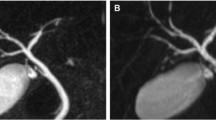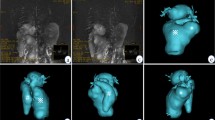Abstract
Purpose
The gallbladder and the biliary tract are structures in close connection with the adjacent organs and may show a number of variations and anomalies. It is therefore important for surgical purposes to know their anatomy and variations in detail. Various methods are used in the imaging of the variations of the biliary tract and its pathologies, including ultrasonography, computed tomography; direct cholangiographic methods like endoscopic retrograde cholangiopancreatography, percutaneous transhepatic cholangiography, intravenous cholangiography and T-tube cholangiography, as well as indirect methods like magnetic resonance cholangiopancreatography (MRCP) or cholescintigraphy. The aim of this study is to investigate the frequency of the anatomic variations of the biliary tract using 3-T MRCP and to compare the findings with the data in the literature.
Materials and methods
For the purposes of this study, patients who underwent MRCP at our hospital (Dicle University Hospital) between November 2009 and February 2012 were investigated retrospectively. A total of 590 patients (between 6 and 88 years of age; mean age: 51 ± 9 years) were included in the study. The MRCP imaging was carried out with an magnetic resonance imaging (MRI) device supplied with 3-T magnetic power and by obtaining T2-weighted images through the single-shot fast spin echo technique using the standard body coil. The axial and coronal source images and the reformatted images were evaluated together in terms of the possible anatomic variations.
Results
Among the 590 patients included in the study, of 233 (39.5 %) showed anatomic variations at different levels in the intra- and extrahepatic biliary tracts. Among these variations, a right posterior hepatic duct insertion to the left hepatic duct at the level of the bifurcation has been observed in 71 patients (12.1 %), trifurcation was observed in 30 patients (5.1 %) and insertion into the main hepatic duct at the proximal aspect of the cystic duct was observed in 18 patients (3.1 %). At the level of the cystic duct, medial insertion of the cystic duct was viewed in 58 patients (9.8 %), distal medial insertion was seen in 40 patients (6.8 %), a short cystic duct was detected in 10 patients (1.7 %), pancreatobiliary junction anomaly was viewed in two patients (0.4 %) and duplicate anatomic variations have been observed in 42 patients (7.2 %).
Conclusion
MRCP studies conducted using 3-T MRI devices may reveal similar or greater numbers of variations when compared to the existing MRCP studies in the literature. 3-T MRI shows a couple of variations. Pointing out these anatomical variations before the surgical intervention may prevent possible iatrogenic traumas. Donors with unsuitable variations for liver transplant may be spotted out at an early phase through the MRCP and certain operations with a high morbidity rate may thus be avoided.




Similar content being viewed by others
References
Choi E, Byun JH, Park BJ, Lee MG (2007) Duplication of the extrahepatic bile duct with anomalous union of the pancreaticobiliary ductal system revealed by MR cholangiopancreatography. Br J Radiol 80(955):150–154
Cotton PB (1980) Congenital anomaly of pancreas divisum as a cause of obstructive pain and pancreatitis. Gut 21(2):105–114
David V, Reinhold C, Hochman M, Chuttani R, McKee J, Waxman I, Wang L, Li W, Kaplan R, Edelman RR (1998) Pitfalls in the interpretation of MR cholangiopancreatography. AJR Am J Roentgenol 170:1055–1059
De Filippo M, Calabrese M, Quinto S, Rastelli A, Bertellini A, Martora R, Sverzellati N, Corradi D, Vitale M, Crialesi G, Sarli L, Roncoroni L, Garlaschi G, Zompatori M (2008) Congenital anomalies and variations of the bile and pancreatic ducts: magnetic resonance cholangiopancreatography findings, epidemiology and clinical significance. Radiol Med 113:841–859
Dohke M, Watanabe Y, Okumura A, Amoh Y, Oda K, Ishimori T, Koike S, Hayashi T, Hiyama A, Dodo Y (1999) Anomalies and anatomic variants of the biliary tree revealed by MR cholangiopancreatography. AJR Am J Roentgenol 173:1251–1254
Düşünceli E, Erden A, Erden I (2004) Anatomic variations of the bile ducts: MRCP findings. Diagn Interv Radiol 10:296–303
Fulcher AS, Szucs RA, Bassignani MJ, Marcos A (2001) Right lobe living donor liver transplantation: preoperative evaluation of the donor with MR ımaging. AJR Am J Roentgenol 176:1483–1491
Gazelle GS, Lee MJ, Mueller PR (1994) Cholangiographic segmental anatomy of the liver. Radiographics 14(5):1005–1013
Heller SL, Lee VS (2005) MR imaging of the gallbladder and biliary system. Magn Reson Imaging Clin N Am 13(2):295–311
Huang TL, Cheng YF, Chen CL, Chen TY, Lee TY (1996) Variants of the bile ducts:clinical application in the potential donor of living-related hepatic transplantation. Transpl proc 28(3):1669–1670
Karakas HM, CelikT Alicioglu B (2008) Bile duct anatomy of the anatolian Caucasian population: Huang classification revisited. Surg Radiol Anat 30(7):539–545
Leyendecker JR, Elsayes KM, Gratz BI, Brown JJ (2002) MR cholangiopancreatography: spectrum of pancreatic duct abnormalities. AJR Am J Roentgenol 179:1465–1471
Martin RF, Rossi RL (1994) Bile duct injuries: spectrum, mechanisms of injury, and their prevention. Surg Clin North Am 74(4):781–807
Meredith G. Beaver (1929) Variations in the extrahepatic biliary tract. Reprinted from the Archives of Surgery August vol. 19, pp 321–326
Morgan DE, Logan K, Baron TH, Koehler RE, Smith JK (1999) Pancreas divisum: implications for diagnostic and therapeutic pancreatography. AJR Am J Roentgenol 173(1):193–198
Mortele K, Ros PR (2001) Anatomic variants of the biliary tree: MR cholangiographic findings and clinical applications. AJR Am J Roentgenol 177:389–394
Puente SG, Bannura GC (1983) Radiological anatomy of the biliary tract: variations and congenital abnormalities. World J Surg 7(2):271–276
Sai J, Ariyama J (2000) MR cholangiopancreatography: early diagnosis of pancreatobiliary disease, 1st edn. Springer, Tokyo, pp 23–28
Schwartz SI (1999) Gallbladder and extrahepatic system. In: Schwartz SI, Shires GT, Spencer FC et al (eds) Principles of surgery, 7th edn. McGraw-Hill, New York
Smadja C, Blumgarth LH (1994) The biliary tract and the anatomy of biliary exposure. In: Blumgarth LH (ed) Surgery of the liver and biliary tract. Churchill-Livingstone, New York, pp 11–21
Taourel P, Bret PM, Reinhold C, Barkun AN, Atri M (1996) Anatomic variants of the biliary tree: diagnosis with MR cholangiopancreatography. Radiology 199(2):521–527
Van Hoe L, Vanbeckevoort D, Steenbergen WV (2001) Atlas of MR cholangiopancreatcography, 1st edn. Springer-Verlag, Berlin, pp 54–59
Varghese JC, Farrell MA, Courtney G, Osborne H, Murray FE, Lee MJ (1999) Role of MR cholangiopancreatography in patients with failed or inadequate ERCP. AJR Am J Roentgenol 173:1527–1533
Conflict of interest
The authors declare that they have no conflict of interest.
Author information
Authors and Affiliations
Corresponding author
Rights and permissions
About this article
Cite this article
Önder, H., Özdemir, M.S., Tekbaş, G. et al. 3-T MRI of the biliary tract variations. Surg Radiol Anat 35, 161–167 (2013). https://doi.org/10.1007/s00276-012-1021-0
Received:
Accepted:
Published:
Issue Date:
DOI: https://doi.org/10.1007/s00276-012-1021-0




